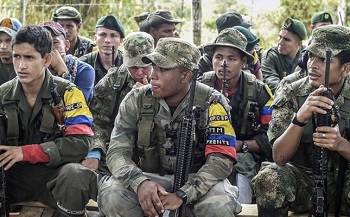Two FARC guerrillas have reportedly been killed by soldiers in Colombia in the first publicly reported violation of a bilateral ceasefire meant to smooth the path towards a peace deal with the left-wing rebels. However, the outbreak of hostilities shows how precarious the process has become.
Two members of the Revolutionary Armed Forces of Colombia (Fuerzas Armadas Revolucionarias de Colombia – FARC) were killed in a November 16 confrontation, despite a bilateral ceasefire that is in effect between the government and the rebel group.
According to a military press release, the guerrillas died in an operation against illegal activities in Santa Rosa municipality, in the south of Bolívar department, while a third surrendered.
The military stated that the armed forces carried out the operation after receiving reports that members of the National Liberation Army (Ejército de Liberación Nacional – ELN) guerrilla group had been extorting locals and running illegal mining operations in the area.
It was only revealed that the guerrillas belonged to the FARC when the demobilized fighter declared that all three were members of the organization’s 37th Front. The demobilized rebel also “handed over exact information on the illegal activities they were carrying out in the area,” the press release states.
SEE ALSO: Coverage of FARC Peace
In addition, Colombian Army Commander in Chief Alberto Mejía told RCN Radio that documents were found on the dead guerrillas that evidenced their extortion activities, and they also found proof that they were collaborating with ELN members.
Nevertheless, head government peace negotiator Humberto de la Calle told Caracol Televisión on November 16 that he had discussed the incident with head FARC negotiator Luciano Marín Arango, alias “Iván Márquez,” who asserted that the rebels were heading to a pre-concentration zone. A number of such areas have been set up for FARC members as they wait for a final peace deal to be implemented and their demobilization process to formally begin.
The army statement affirms that the rebels were 68 kilometers away from a pre-concentration zone. But General Mejía claimed that the rebels were not in any “humanitarian [movement] corridors” seemingly set up to facilitate entry to the zones.
FARC peace delegate Carlos Lozada tweeted on Wednesday that the Colombian Army’s “version of events on the death of guerrillas in southern Bolívar lacks validity.” In the same message, Lozada called for the tripartite monitoring and verification mechanism (mecanismo tripartito de monitoreo y verificación – MMV) made up of representatives of the United Nations, the Colombian government and the FARC to clarify the circumstances of the clash.
The bilateral ceasefire between the Colombian government and the rebels was declared on August 29, and was extended in October through the end of the year.
The last reported clash between the FARC and government forces took place on July 8 in Meta department, during which three guerrillas were injured, according to conflict analysis center CERAC, which monitors the ceasefire.
InSight Crime Analysis
This recent clash is a reminder that FARC members remain in a risky limbo that opens the door for escalating violence and a return of the guerrillas to criminal activities.
Since Colombian voters rejected an initial peace deal with the FARC in a plebiscite on October 2, the years-long process has been on unsteady ground. A modified agreement has since been signed but still needs legal approval before it is set into motion, and it remains unclear if and when this might happen.
Where the rebels are — or are not — gathering poses one dilemma. Implementing the official accord would allow guerrillas to move to protected concentration zones, where they would hand over their weapons to United Nations representatives. But as CERAC points out, the rebels’ temporary pre-concentration zones do not have solid controls for entering and leaving, which “raises the risk that members of the guerrilla group will carry out individual violent actions.”
SEE ALSO: Coverage of Extortion
As InSight Crime has stated in the past, delays in implementing the official deal also increase the chances of dissident guerrilla groups breaking away from the core structure to further their criminal activities. The recent events in Bolívar may well have been just one example of FARC members ignoring its leadership’s orders to stop extorting.
Furthermore, conflicting narratives surrounding the FARC deaths could exacerbate underlying political tensions. Supporters of the peace agreement will likely see the incident as a reason to accelerate the peace process in order to avoid further confrontations, while opponents will likely point to the clash as evidence that the FARC cannot be trusted to keep promises made in the negotiations.

